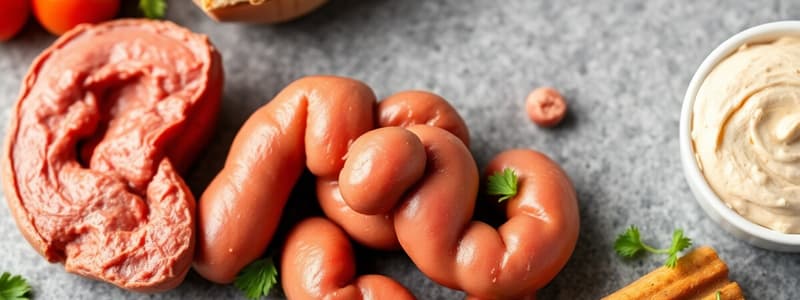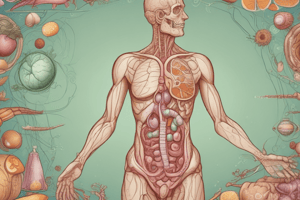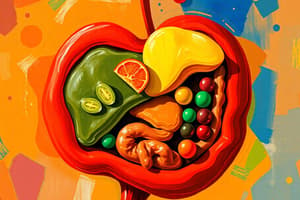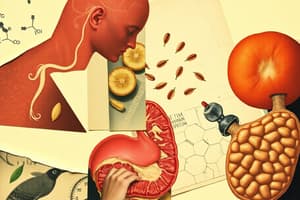Podcast
Questions and Answers
What is a key characteristic of proteins when they are ingested as part of the diet?
What is a key characteristic of proteins when they are ingested as part of the diet?
- They consist mainly of carbohydrates.
- They require enzymes to remain intact.
- They are denatured upon cooking, making them easier to digest. (correct)
- They are instantly absorbed unchanged.
How much protein is typically lost through feces in healthy humans?
How much protein is typically lost through feces in healthy humans?
- 0-2 g/day
- 20-25 g/day
- 30-40 g/day
- 5-10 g/day (correct)
What type of protein metabolism occurs when nitrogen intake is equal to nitrogen output in healthy adults?
What type of protein metabolism occurs when nitrogen intake is equal to nitrogen output in healthy adults?
- Negative nitrogen balance
- Protein excess
- Nitrogen equilibrium (correct)
- Positive nitrogen balance
Which of the following is NOT a role of proteins in the body?
Which of the following is NOT a role of proteins in the body?
Which proteolytic enzyme is secreted as an inactive zymogen and activated in the intestinal lumen?
Which proteolytic enzyme is secreted as an inactive zymogen and activated in the intestinal lumen?
What is the role of endopeptidases in protein digestion?
What is the role of endopeptidases in protein digestion?
Which essential amino acid is missing from proteins of maize?
Which essential amino acid is missing from proteins of maize?
What type of nitrogen balance typically occurs in elderly people or those with chronic diseases?
What type of nitrogen balance typically occurs in elderly people or those with chronic diseases?
Flashcards
Structural proteins
Structural proteins
Proteins act as the building blocks for tissues, muscles, organs, and enzymes. They provide structure and support to the body.
Catalytic proteins (Enzymes)
Catalytic proteins (Enzymes)
Proteins facilitate chemical reactions by acting as biological catalysts, speeding up reactions without being consumed themselves.
Transport proteins
Transport proteins
Proteins bind and transport molecules such as oxygen, hormones, and nutrients throughout the body.
Regulatory proteins
Regulatory proteins
Signup and view all the flashcards
Protective proteins
Protective proteins
Signup and view all the flashcards
Homeostatic proteins
Homeostatic proteins
Signup and view all the flashcards
Accumulating proteins
Accumulating proteins
Signup and view all the flashcards
Protein metabolism
Protein metabolism
Signup and view all the flashcards
Study Notes
Protein Digestion Overview
- Protein intake is 50-100g daily.
- Dietary proteins are denatured by cooking, making them more easily digested.
- Protein digestion and absorption are efficient in healthy humans, with minimal loss through feces (5-10g daily).
Protein Roles in the Body
- Proteins are involved in structural support, catalysis (enzymes), and transport.
- They also play regulatory, protective, homeostatic, and accumulating roles.
Protein Metabolism Dynamics
- Daily protein hydrolysis is approximately 400g.
- Daily protein synthesis is also roughly 400g.
- Daily protein requirements are approximately 100g.
- Proteins have a half-renewal time of 80 days.
Nitrogen Balance
- Nitrogen balance is a measure of protein metabolism.
- Positive nitrogen balance occurs when nitrogen intake exceeds loss (usually in children).
- Negative nitrogen balance occurs when nitrogen loss exceeds intake (often in elderly people or those with chronic illnesses).
- Nitrogen equilibrium is when intake equals loss.
Essential and Non-Essential Amino Acids
- Essential amino acids cannot be synthesized by the body and must be obtained through diet.
- Non-essential amino acids can be synthesized by the body.
- Essential amino acids include Thr, His, Trp, Phe, Lys, Val, Leu, and Ile.
- 30-40% of protein forms muscles.
Food Protein Content Examples
- Specific food examples and protein content per 100g are provided.
Protein Digestion in Stomach
- Gastric juice contains HCl and pepsinogen.
- HCl denatures proteins and kills microorganisms, creating an optimal pH for pepsin.
- Pepsinogen is converted to pepsin by HCl, breaking proteins down into smaller peptides.
Protein Digestion in Small Intestine
- Pancreatic enzymes like trypsin, chymotrypsin, elastase, and carboxypeptidases continue protein digestion in the small intestine.
- Enteropeptidase activates trypsin.
- Trypsin activates other pancreatic enzymes.
- Brush border enzymes such as aminopeptidases, carboxypeptidases, and dipeptidases further break down peptides into amino acids.
Intestinal Digestion of Proteins
- Aminopeptidases and dipeptidases in the intestinal lining complete protein digestion.
- Aminopeptidases cleave amino acids from the N-terminus of peptides.
- Dipeptidases break down dipeptides into amino acids.
Absorption of Amino Acids
- Amino acid absorption in the small intestine involves carrier-mediated transport.
- Various amino acids are transported via different carriers (e.g., neutral, basic, acidic, imino).
- Some systems are sodium-dependent.
Metabolism of Indole and other substances
- Bacteria in the colon metabolize tryptophan to indole and skatole.
- Indole is further metabolized to indoxyl.
- Phenylalanine can be metabolized to phenol.
Diagnostic Value of Indican in Urine
- Elevated indican in urine may indicate intestinal blockage, excessive protein breakdown, or kidney issues.
Disorders of Gastric Acidity
- Hyperchlorhydria is increased acidity.
- Hypochlorhydria is decreased acidity.
- Achlorohydria is the absence of HCl.
- Achylia is the absence of gastric juice.
Pancreatic Digestion Enzymes
- Pancreatic juices contain proteolytic enzymes (trypsin, chymotrypsin, elastase).
Carboxypeptidases
- Carboxypeptidases further break down peptides, releasing free amino acids.
Other Key Concepts/Processes
- Mucopolysaccharides protect intestinal cells from stomach acid.
- There are different types of proteolytic enzymes (endo and exopeptidases).
- The stomach pH is extremely low, which is important for pepsin function.
Studying That Suits You
Use AI to generate personalized quizzes and flashcards to suit your learning preferences.
Related Documents
Description
Explore the intricate processes of protein digestion and metabolism in this quiz. Learn about the roles of proteins in the body, daily requirements, and the significance of nitrogen balance. Test your knowledge on how proteins are processed and utilized by the human body.




